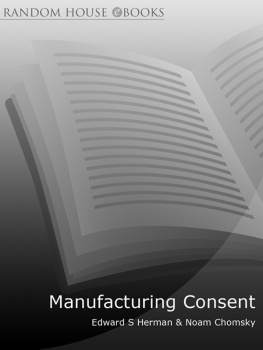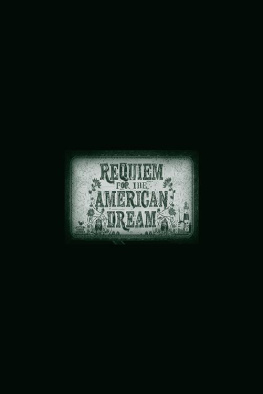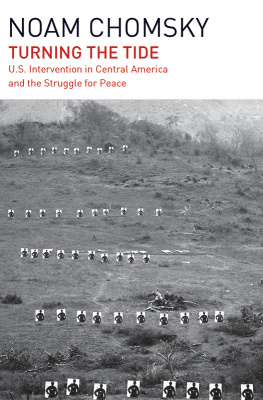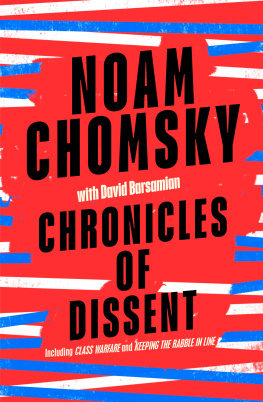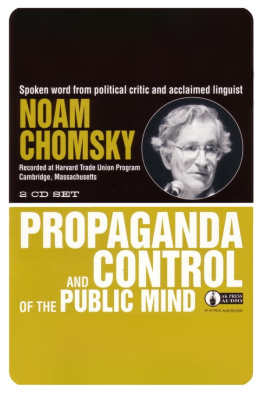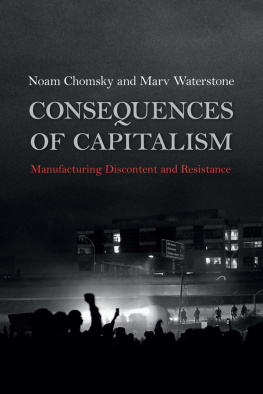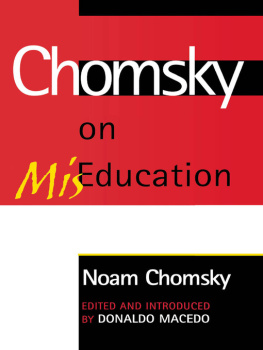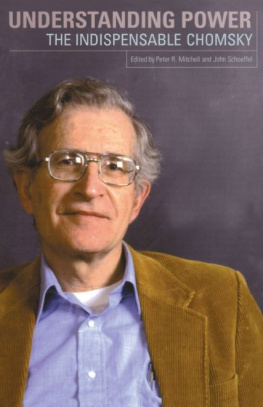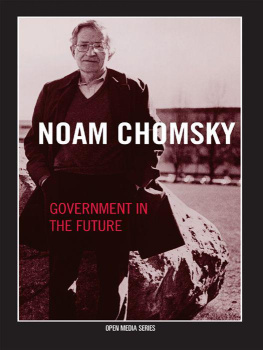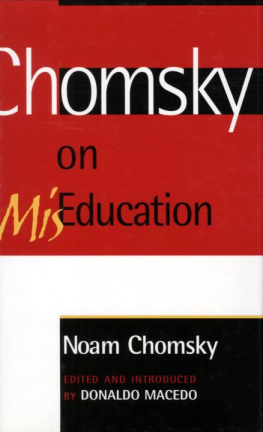Noam Chomsky - Manufacturing Consent
Here you can read online Noam Chomsky - Manufacturing Consent full text of the book (entire story) in english for free. Download pdf and epub, get meaning, cover and reviews about this ebook. genre: Politics. Description of the work, (preface) as well as reviews are available. Best literature library LitArk.com created for fans of good reading and offers a wide selection of genres:
Romance novel
Science fiction
Adventure
Detective
Science
History
Home and family
Prose
Art
Politics
Computer
Non-fiction
Religion
Business
Children
Humor
Choose a favorite category and find really read worthwhile books. Enjoy immersion in the world of imagination, feel the emotions of the characters or learn something new for yourself, make an fascinating discovery.
- Book:Manufacturing Consent
- Author:
- Genre:
- Rating:5 / 5
- Favourites:Add to favourites
- Your mark:
- 100
- 1
- 2
- 3
- 4
- 5
Manufacturing Consent: summary, description and annotation
We offer to read an annotation, description, summary or preface (depends on what the author of the book "Manufacturing Consent" wrote himself). If you haven't found the necessary information about the book — write in the comments, we will try to find it.
Manufacturing Consent — read online for free the complete book (whole text) full work
Below is the text of the book, divided by pages. System saving the place of the last page read, allows you to conveniently read the book "Manufacturing Consent" online for free, without having to search again every time where you left off. Put a bookmark, and you can go to the page where you finished reading at any time.
Font size:
Interval:
Bookmark:

Consent
The Political Economy of the Mass Media
EDWARD S. HERMAN
and NOAM CHOMSKY
With a new afterword by Edward S. Herman

This eBook is copyright material and must not be copied, reproduced, transferred, distributed, leased, licensed or publicly performed or used in any way except as specifically permitted in writing by the publishers, as allowed under the terms and conditions under which it was purchased or as strictly permitted by applicable copyright law. Any unauthorised distribution or use of this text may be a direct infringement of the authors and publishers rights and those responsible may be liable in law accordingly.
Version 1.0
Epub ISBN 9781407054056
www.randomhouse.co.uk
Published by The Bodley Head 2008
10 9 8 7 6 5 4 3 2 1
Copyright Edward S. Herman and Noam Chomsky 1988 Introduction Edward S. Herman and Noam Chomsky 2002 Afterword Edward S. Herman 2008
Noam Chomsky and Edward S. Herman have asserted their right under the Copyright, Designs and Patents Act 1988 to be identified as the authors of this work
This book is sold subject to the condition that it shall not, by way of trade or otherwise, be lent, resold, hired out, or otherwise circulated without the publishers prior consent in any form of binding or cover other than that in which it is published and without a similar condition, including this condition, being imposed on the subsequent purchaser.
First published in Great Britain in 2008 by The Bodley Head Random House, 20 Vauxhall Bridge Road, London SW1V 2SA
www.rbooks.co.uk
Addresses for companies within The Random House Group Limited can be found at: www.randomhouse.co.uk/offices.htm
The Random House Group Limited Reg. No. 954009
A CIP catalogue record for this book is available from the British Library
ISBN 9781847920706
The Random House Group Limited supports The Forest Stewardship Council (FSC), the leading international forest certification organisation. All our titles that are printed on Greenpeace approved FSC certified paper carry the FSC logo. Our paper procurement policy can be found at www.rbooks.co.uk/environment

Typeset in Fournier MT by Palimpsest Book Production Limited, Grangemouth, Stirlingshire
Printed and bound in Great Britain by Clays Ltd, St Ives PLC
TO THE MEMORY OF ALEX CAREY
AND
HERBERT I. SCHILLER
By the same authors
The Political Economy of Human Rights:
The Washington Connection and Third World Fascism
The Political Economy of Human Rights 2:
After the Cataclysm
The Iran-contra scandals were blamed on the Presidents easygoing habits, though the people had every opportunity to know this was his way of doing things or not doing before they put him in the White House, not once but twice.
James Reston
They who have put out the peoples eyes, reproach them of their blindness.
John Milton
Mainstream Media Usage of Genocide for Kosovo, East Timor, Turkey, and Iraq
This book centers in what we call a Propaganda model, an analytical framework that attempts to explain the performance of the U.S. media in terms of the basic institutional structures and relationships within which they operate. It is our view that, among their other functions, the media serve, and propagandize on behalf of, the powerful societal interests that control and finance them. The representatives of these interests have important agendas and principles that they want to advance, and they are well positioned to shape and constrain media policy. This is normally not accomplished by crude intervention, but by the selection of right-thinking personnel and by the editors and working journalists internalization of priorities and definitions of newsworthiness that conform to the institutions policy.
Structural factors are those such as ownership and control, dependence on other major funding sources (notably, advertisers), and mutual interests and relationships between the media and those who make the news and have the power to define it and explain what it means. The propaganda model also incorporates other closely related factors such as the ability to complain about the medias treatment of news (that is, produce flak), to provide experts to confirm the official slant on the news, and to fix the basic principles and ideologies that are taken for granted by media personnel and the elite, but are often resisted by the general population.believe that what journalists do, what they see as newsworthy, and what they take for granted as premises of their work are frequently well explained by the incentives, pressures, and constraints incorporated into such a structural analysis.
These structural factors that dominate media operations are not allcontrolling and do not always produce simple and homogeneous results. It is well recognized, and may even be said to constitute a part of an institutional critique such as we present in this volume, that the various parts of media organizations have some limited autonomy, that individual and professional values influence media work, that policy is imperfectly enforced, and that media policy itself may allow some measure of dissent and reporting that calls into question the accepted viewpoint. These considerations all work to assure some dissent and coverage of inconvenient facts. The beauty of the system, however, is that such dissent and inconvenient information are kept within bounds and at the margins, so that while their presence shows that the system is not monolithic, they are not large enough to interfere unduly with the domination of the official agenda.
It should also be noted that we are talking about media structure and performance, not the effects of the media on the public. Certainly, the medias adherence to an official agenda with little dissent is likely to influence public opinion in the desired direction, but this is a matter of degree, and where the publics interests diverge sharply from that of the elite, and where they have their own independent sources of information, the official line may be widely doubted. The point that we want to stress here, however, is that the propaganda model describes forces that shape what the media does; it does not imply that any propaganda emanating from the media is always effective.
Although now more than a dozen years old, both the propaganda model and the case studies presented with it in the first edition of this book have held up remarkably well. The purpose of this new Introduction is to update the model, add some materials to supplement the case studies already in place (and left intact in the chapters that follow), and finally, to point out the possible applicability of the model to a number of issues under current or recent debate.
The propaganda model, spelled out in detail in economic system. For this reason, we focused heavily on the rise in scale of media enterprise, the medias gradual centralization and concentration, the growth of media conglomerates that control many different kinds of media (motion picture studios, TV networks, cable channels, magazines, and book publishing houses), and the spread of the media across borders in a globalization process. We also noted the gradual displacement of family control by professional managers serving a wider array of owners and more closely subject to market discipline.
Font size:
Interval:
Bookmark:
Similar books «Manufacturing Consent»
Look at similar books to Manufacturing Consent. We have selected literature similar in name and meaning in the hope of providing readers with more options to find new, interesting, not yet read works.
Discussion, reviews of the book Manufacturing Consent and just readers' own opinions. Leave your comments, write what you think about the work, its meaning or the main characters. Specify what exactly you liked and what you didn't like, and why you think so.

